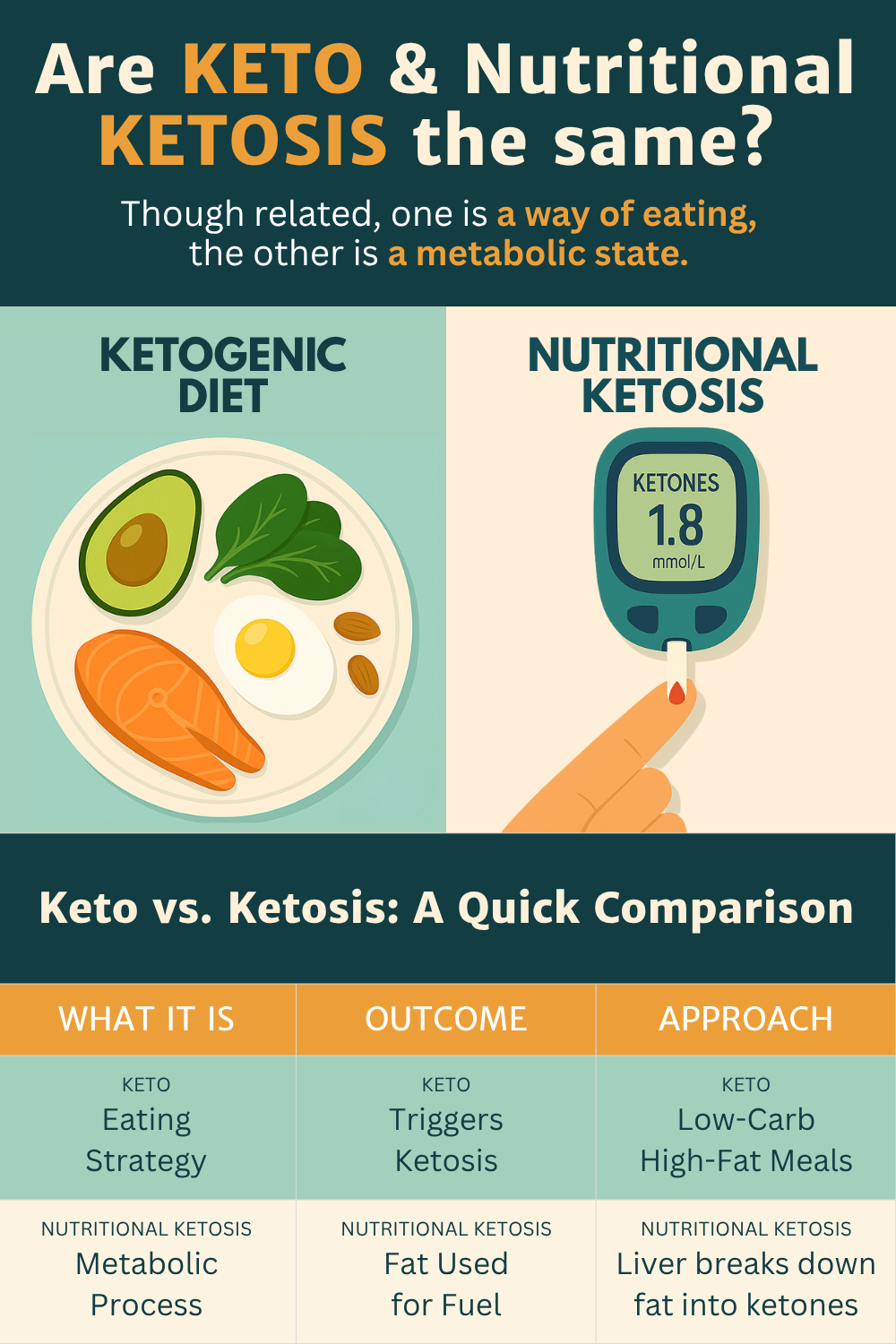
Are Keto and Nutritional Ketosis the Same?
June 11, 2025Are Keto and Nutritional Ketosis the Same? With low-carb diets on the rise again, buzzwords like “keto” and “ketosis” get tossed around often, but are they really the same thing? Not exactly. While they are related, one is a way of eating while the other is a metabolic state your body enters. So let’s break them down.
Keto: The Diet
The ketogenic diet, or keto for short, is a way of eating that drastically reduces carbohydrates and increases fat. Typically, only about 5–10% of your daily calories come from carbs when following a keto eating style. The goal? To get your body into a state called ketosis. This is when your body uses fat, in the form of ketones, as its main energy source instead of carbohydrates.
Nutritional Ketosis: The Metabolic State
Nutritional Ketosis is the actual metabolic state that occurs when the intake of carbohydrates in the body is too low, usually around 50 grams or less. When the body is starved of carbs, it needs to make energy, so the liver starts to break down fat into molecules called ketones. These ketones can be used to fuel the body and the brain. As long as the body is being starved of its preferred fuel source, it will continue to be in ketosis, the main goal of the ketogenic diet.
So what’s the deal with keto?
A Little History
The ketogenic diet originated in 1921 when Dr. Russell Wilder used it to treat epilepsy after he noticed it reduced the frequency of seizures in patients. By the 60s and 70s, the keto diet exploded in popularity after its use in treating obesity, effectively becoming a new weight loss tool. How does it help with weight loss? With fewer carbs available to burn, the body has to shift gears to find a new energy source, inevitably turning to ketones. These ketones are made by breaking down stored fat, thus resulting in weight loss. It also depletes your carb storage tanks, aka your glycogen stores, which tend to hoard a lot of water, so draining this leads to quick water weight loss and reduced bloating.
Being in Ketosis: What to Know
While the keto diet is a method of eating, nutritional ketosis is the physiological result. Just because someone says they are in ketosis does not mean they are actually in ketosis. The only way to truly know is to check your ketones. To do this, you can purchase over-the-counter urine test strips, which are affordable but not as accurate, or you can purchase a glucose meter, as some can test for ketones in addition to glucose levels, but these tend to be pricier
While the short-term effects of the keto diet are well-researched, the data on long-term outcomes is limited. Some people experience what’s known as the “keto flu” a few days after starting the diet, complaining of symptoms like fatigue, headaches, nausea, and general sluggishness. This usually passes as the body adjusts. For long-term impacts on the body, some people might experience higher cholesterol levels and increased risks of heart disease or miss out on certain nutrients due to the restrictive nature of the diet and lack of emphasis on a variety of fruits and vegetables. On the flip side, some studies have shown improvements in total cholesterol levels, blood sugar, and even blood pressure in certain individuals. While the ketogenic diet can be a great tool for improving some health outcomes, it is often not sustainable, as many people find it hard to limit the carbs they love and stay in ketosis long-term.
What would a Keto Diet look like?
What to Eat and What to Avoid
A big part of the ketogenic diet is knowing what to eat and what to avoid in order to stay in ketosis. Here’s a quick rundown:
Keto-friendly Foods:
- Protein: Eggs, fatty fish (like salmon), chicken, beef
- Fats: Avocados, coconut oil, olive oil, nuts, and seeds
- Veggies: Spinach, kale, broccoli, cauliflower, zucchini
- Dairy: Cheese, heavy cream, Greek yogurt (full-fat, low-carb)
- Drinks: Water, coffee, tea (unsweetened)
Foods to Avoid:
- Bread, pasta, rice, cereal
- Most fruits (except small portions of berries)
- Sugary drinks and snacks (sodas, candy, cakes and cookies, juices)
- Beans and legumes
- Starchy vegetables (like potatoes and corn)
A typical day of meals might look like this:
Breakfast: Cheese and spinach omelet with avocado and a side of bacon
Lunch: Caesar salad with grilled chicken
Dinner: Salmon with roasted cauliflower and sautéed greens
Snacks: boiled eggs, beef jerky, chicken salad
Keto and Nutritional Ketosis Bottom Line
Nutritional ketosis is essentially the body’s fat-burning mode that engages in times of carbohydrate starvation; the keto diet is a way to get there. Whether you’re curious about low-carb living for weight loss, health reasons, or just to try something new, it’s best to speak with your doctor or a registered dietitian first.
Reference:
Masood, W. (2023, June 16). Ketogenic diet. In StatPearls. StatPearls Publishing. https://www.ncbi.nlm.nih.gov/books/NBK499830/
Beth Heise, RD specializes in bariatric and weight management nutrition and is currently advancing her expertise by pursuing a Master’s degree in Exercise Science and Integrated Wellness at Bastyr University.

ABOUT THE AUTHOR Beth Heise is a registered dietitian specializing in bariatric and weight management nutrition. Passionate about bridging the gap between nutrition and movement, she is currently advancing her expertise by pursuing a Master’s degree in Exercise Science and Integrated Wellness at Bastyr University. With a strong foundation in science and a client-centered approach, she empowers individuals to make sustainable lifestyle changes that support long-term health and wellness. |



